Evaluating Leadership Styles and CSR Practices at Tesco
VerifiedAdded on 2023/06/15
|14
|4305
|180
Report
AI Summary
This report provides an overview of Tesco's leadership styles, focusing on the democratic approach and its impact on employee motivation and strategic decision-making. It explores Tesco's value-based approach, emphasizing customer service, community engagement, and sustainability. The anal...

Leadership
Paraphrase This Document
Need a fresh take? Get an instant paraphrase of this document with our AI Paraphraser

Table of Contents

Introduction......................................................................................................................................1
Overview of Tesco...........................................................................................................................1
Leader and leadership style of Tesco...............................................................................................3
Value based approach and ethics of Tesco......................................................................................4
Corporate social responsibility (CSR) and Carroll model...............................................................5
Tesco’s corporate social responsibility............................................................................................6
Recommendations............................................................................................................................7
Tesco’s leadership and corporate social responsibility....................................................................8
Conclusion.......................................................................................................................................8
References......................................................................................................................................10
Overview of Tesco...........................................................................................................................1
Leader and leadership style of Tesco...............................................................................................3
Value based approach and ethics of Tesco......................................................................................4
Corporate social responsibility (CSR) and Carroll model...............................................................5
Tesco’s corporate social responsibility............................................................................................6
Recommendations............................................................................................................................7
Tesco’s leadership and corporate social responsibility....................................................................8
Conclusion.......................................................................................................................................8
References......................................................................................................................................10
⊘ This is a preview!⊘
Do you want full access?
Subscribe today to unlock all pages.

Trusted by 1+ million students worldwide

Paraphrase This Document
Need a fresh take? Get an instant paraphrase of this document with our AI Paraphraser
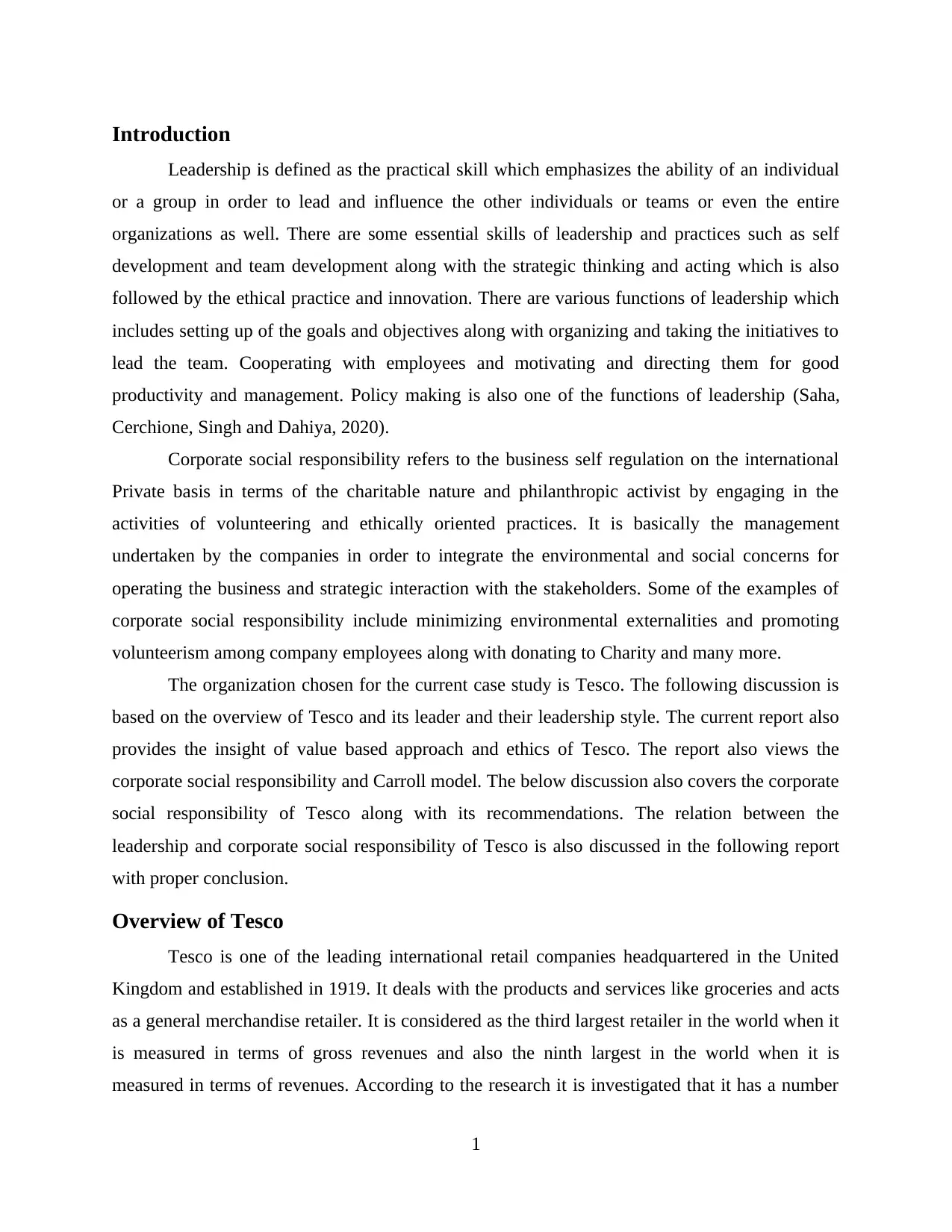
Introduction
Leadership is defined as the practical skill which emphasizes the ability of an individual
or a group in order to lead and influence the other individuals or teams or even the entire
organizations as well. There are some essential skills of leadership and practices such as self
development and team development along with the strategic thinking and acting which is also
followed by the ethical practice and innovation. There are various functions of leadership which
includes setting up of the goals and objectives along with organizing and taking the initiatives to
lead the team. Cooperating with employees and motivating and directing them for good
productivity and management. Policy making is also one of the functions of leadership (Saha,
Cerchione, Singh and Dahiya, 2020).
Corporate social responsibility refers to the business self regulation on the international
Private basis in terms of the charitable nature and philanthropic activist by engaging in the
activities of volunteering and ethically oriented practices. It is basically the management
undertaken by the companies in order to integrate the environmental and social concerns for
operating the business and strategic interaction with the stakeholders. Some of the examples of
corporate social responsibility include minimizing environmental externalities and promoting
volunteerism among company employees along with donating to Charity and many more.
The organization chosen for the current case study is Tesco. The following discussion is
based on the overview of Tesco and its leader and their leadership style. The current report also
provides the insight of value based approach and ethics of Tesco. The report also views the
corporate social responsibility and Carroll model. The below discussion also covers the corporate
social responsibility of Tesco along with its recommendations. The relation between the
leadership and corporate social responsibility of Tesco is also discussed in the following report
with proper conclusion.
Overview of Tesco
Tesco is one of the leading international retail companies headquartered in the United
Kingdom and established in 1919. It deals with the products and services like groceries and acts
as a general merchandise retailer. It is considered as the third largest retailer in the world when it
is measured in terms of gross revenues and also the ninth largest in the world when it is
measured in terms of revenues. According to the research it is investigated that it has a number
1
Leadership is defined as the practical skill which emphasizes the ability of an individual
or a group in order to lead and influence the other individuals or teams or even the entire
organizations as well. There are some essential skills of leadership and practices such as self
development and team development along with the strategic thinking and acting which is also
followed by the ethical practice and innovation. There are various functions of leadership which
includes setting up of the goals and objectives along with organizing and taking the initiatives to
lead the team. Cooperating with employees and motivating and directing them for good
productivity and management. Policy making is also one of the functions of leadership (Saha,
Cerchione, Singh and Dahiya, 2020).
Corporate social responsibility refers to the business self regulation on the international
Private basis in terms of the charitable nature and philanthropic activist by engaging in the
activities of volunteering and ethically oriented practices. It is basically the management
undertaken by the companies in order to integrate the environmental and social concerns for
operating the business and strategic interaction with the stakeholders. Some of the examples of
corporate social responsibility include minimizing environmental externalities and promoting
volunteerism among company employees along with donating to Charity and many more.
The organization chosen for the current case study is Tesco. The following discussion is
based on the overview of Tesco and its leader and their leadership style. The current report also
provides the insight of value based approach and ethics of Tesco. The report also views the
corporate social responsibility and Carroll model. The below discussion also covers the corporate
social responsibility of Tesco along with its recommendations. The relation between the
leadership and corporate social responsibility of Tesco is also discussed in the following report
with proper conclusion.
Overview of Tesco
Tesco is one of the leading international retail companies headquartered in the United
Kingdom and established in 1919. It deals with the products and services like groceries and acts
as a general merchandise retailer. It is considered as the third largest retailer in the world when it
is measured in terms of gross revenues and also the ninth largest in the world when it is
measured in terms of revenues. According to the research it is investigated that it has a number
1
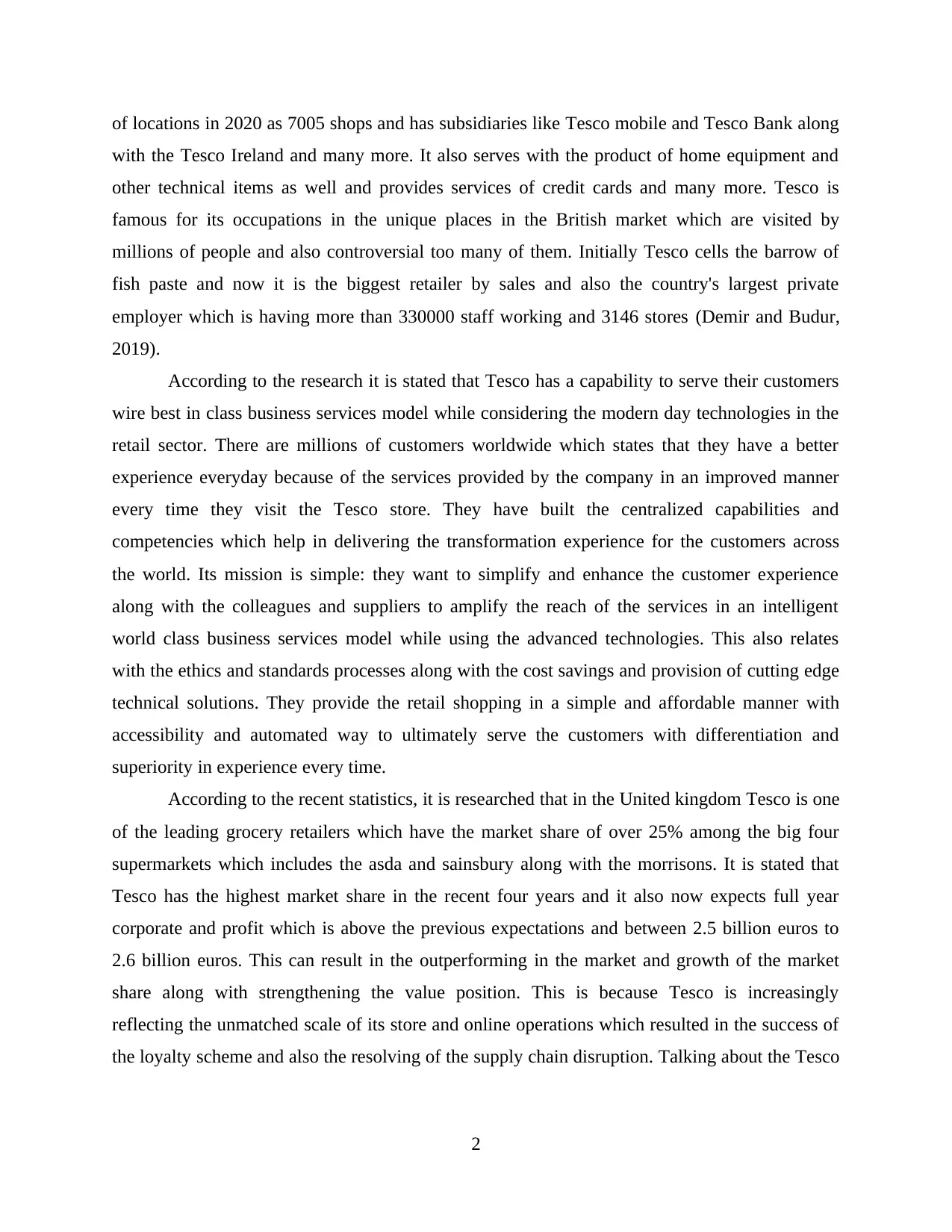
of locations in 2020 as 7005 shops and has subsidiaries like Tesco mobile and Tesco Bank along
with the Tesco Ireland and many more. It also serves with the product of home equipment and
other technical items as well and provides services of credit cards and many more. Tesco is
famous for its occupations in the unique places in the British market which are visited by
millions of people and also controversial too many of them. Initially Tesco cells the barrow of
fish paste and now it is the biggest retailer by sales and also the country's largest private
employer which is having more than 330000 staff working and 3146 stores (Demir and Budur,
2019).
According to the research it is stated that Tesco has a capability to serve their customers
wire best in class business services model while considering the modern day technologies in the
retail sector. There are millions of customers worldwide which states that they have a better
experience everyday because of the services provided by the company in an improved manner
every time they visit the Tesco store. They have built the centralized capabilities and
competencies which help in delivering the transformation experience for the customers across
the world. Its mission is simple: they want to simplify and enhance the customer experience
along with the colleagues and suppliers to amplify the reach of the services in an intelligent
world class business services model while using the advanced technologies. This also relates
with the ethics and standards processes along with the cost savings and provision of cutting edge
technical solutions. They provide the retail shopping in a simple and affordable manner with
accessibility and automated way to ultimately serve the customers with differentiation and
superiority in experience every time.
According to the recent statistics, it is researched that in the United kingdom Tesco is one
of the leading grocery retailers which have the market share of over 25% among the big four
supermarkets which includes the asda and sainsbury along with the morrisons. It is stated that
Tesco has the highest market share in the recent four years and it also now expects full year
corporate and profit which is above the previous expectations and between 2.5 billion euros to
2.6 billion euros. This can result in the outperforming in the market and growth of the market
share along with strengthening the value position. This is because Tesco is increasingly
reflecting the unmatched scale of its store and online operations which resulted in the success of
the loyalty scheme and also the resolving of the supply chain disruption. Talking about the Tesco
2
with the Tesco Ireland and many more. It also serves with the product of home equipment and
other technical items as well and provides services of credit cards and many more. Tesco is
famous for its occupations in the unique places in the British market which are visited by
millions of people and also controversial too many of them. Initially Tesco cells the barrow of
fish paste and now it is the biggest retailer by sales and also the country's largest private
employer which is having more than 330000 staff working and 3146 stores (Demir and Budur,
2019).
According to the research it is stated that Tesco has a capability to serve their customers
wire best in class business services model while considering the modern day technologies in the
retail sector. There are millions of customers worldwide which states that they have a better
experience everyday because of the services provided by the company in an improved manner
every time they visit the Tesco store. They have built the centralized capabilities and
competencies which help in delivering the transformation experience for the customers across
the world. Its mission is simple: they want to simplify and enhance the customer experience
along with the colleagues and suppliers to amplify the reach of the services in an intelligent
world class business services model while using the advanced technologies. This also relates
with the ethics and standards processes along with the cost savings and provision of cutting edge
technical solutions. They provide the retail shopping in a simple and affordable manner with
accessibility and automated way to ultimately serve the customers with differentiation and
superiority in experience every time.
According to the recent statistics, it is researched that in the United kingdom Tesco is one
of the leading grocery retailers which have the market share of over 25% among the big four
supermarkets which includes the asda and sainsbury along with the morrisons. It is stated that
Tesco has the highest market share in the recent four years and it also now expects full year
corporate and profit which is above the previous expectations and between 2.5 billion euros to
2.6 billion euros. This can result in the outperforming in the market and growth of the market
share along with strengthening the value position. This is because Tesco is increasingly
reflecting the unmatched scale of its store and online operations which resulted in the success of
the loyalty scheme and also the resolving of the supply chain disruption. Talking about the Tesco
2
⊘ This is a preview!⊘
Do you want full access?
Subscribe today to unlock all pages.

Trusted by 1+ million students worldwide

annual revenue in recent years is 75 491 million dollars in 2018. 84 331 million dollars in 2019
and 80 2776 million dollars in 2020 and the last 75022 million dollars in 2021.
Tesco is highly involved in the activities of corporate social responsibilities and
sustainability while practicing the leadership in the organization in a strategic manager while
handling all the members in the team who are responsible for individual functions and
collaborative functions as well (Liu, Wei, Choi and Yan, 2021).
Leader and leadership style of Tesco
There are various leadership styles which are followed by Tesco but one of the most
adopted styles is the democratic style of leadership which is followed by every leader in Tesco
who manages the different teams in a collaborative Manner. This is a style which is also known
as the participant leadership in which the employee interactions are maximum and they can
participate in the decision making process. Leaders of Tesco have the nature of motivating their
employees by adopting the democratic style of leadership so that the company can continue to
provide their good services to the customers at a good satisfaction level and experience. Leaders
in Tesco are responsible to clear the roles and responsibilities of each and every individual so
that the strategic decision-making can be effectively communicated with the help of meetings
and brainstorming processes among the employees of the organization. The management style of
Tesco is also democratic in nature in which the manager of operations is decentralized and the
information is communicated from the higher management to the lower management so that
everyone can be free to interact and allow to bring up the initiatives and innovative ideas for the
growth of the organization (Kim and Thapa, 2018).
So basically the management of Tesco and the leaders empower the employees and
consider the important asset of the organization. Moreover Tesco motivates their employees by
giving them benefits and rewards by offering the whole package in terms of money and safety
and security for future along with the health payments and holiday or staff discount card and
award winning pension scheme as well. Tesco always improves its Management process and
leadership style in order to operate the customer management so that along with the listening of
the employees they can also listen to the customer's voice for better servicing in the company.
Tesco is considered customer oriented and always tries to keep up to date with the customer so
that they can satisfy them and produce what the customers are requiring in order to fulfill their
demands. Democratic leadership style is adopted by Tesco which supports every staff to be a part
3
and 80 2776 million dollars in 2020 and the last 75022 million dollars in 2021.
Tesco is highly involved in the activities of corporate social responsibilities and
sustainability while practicing the leadership in the organization in a strategic manager while
handling all the members in the team who are responsible for individual functions and
collaborative functions as well (Liu, Wei, Choi and Yan, 2021).
Leader and leadership style of Tesco
There are various leadership styles which are followed by Tesco but one of the most
adopted styles is the democratic style of leadership which is followed by every leader in Tesco
who manages the different teams in a collaborative Manner. This is a style which is also known
as the participant leadership in which the employee interactions are maximum and they can
participate in the decision making process. Leaders of Tesco have the nature of motivating their
employees by adopting the democratic style of leadership so that the company can continue to
provide their good services to the customers at a good satisfaction level and experience. Leaders
in Tesco are responsible to clear the roles and responsibilities of each and every individual so
that the strategic decision-making can be effectively communicated with the help of meetings
and brainstorming processes among the employees of the organization. The management style of
Tesco is also democratic in nature in which the manager of operations is decentralized and the
information is communicated from the higher management to the lower management so that
everyone can be free to interact and allow to bring up the initiatives and innovative ideas for the
growth of the organization (Kim and Thapa, 2018).
So basically the management of Tesco and the leaders empower the employees and
consider the important asset of the organization. Moreover Tesco motivates their employees by
giving them benefits and rewards by offering the whole package in terms of money and safety
and security for future along with the health payments and holiday or staff discount card and
award winning pension scheme as well. Tesco always improves its Management process and
leadership style in order to operate the customer management so that along with the listening of
the employees they can also listen to the customer's voice for better servicing in the company.
Tesco is considered customer oriented and always tries to keep up to date with the customer so
that they can satisfy them and produce what the customers are requiring in order to fulfill their
demands. Democratic leadership style is adopted by Tesco which supports every staff to be a part
3
Paraphrase This Document
Need a fresh take? Get an instant paraphrase of this document with our AI Paraphraser
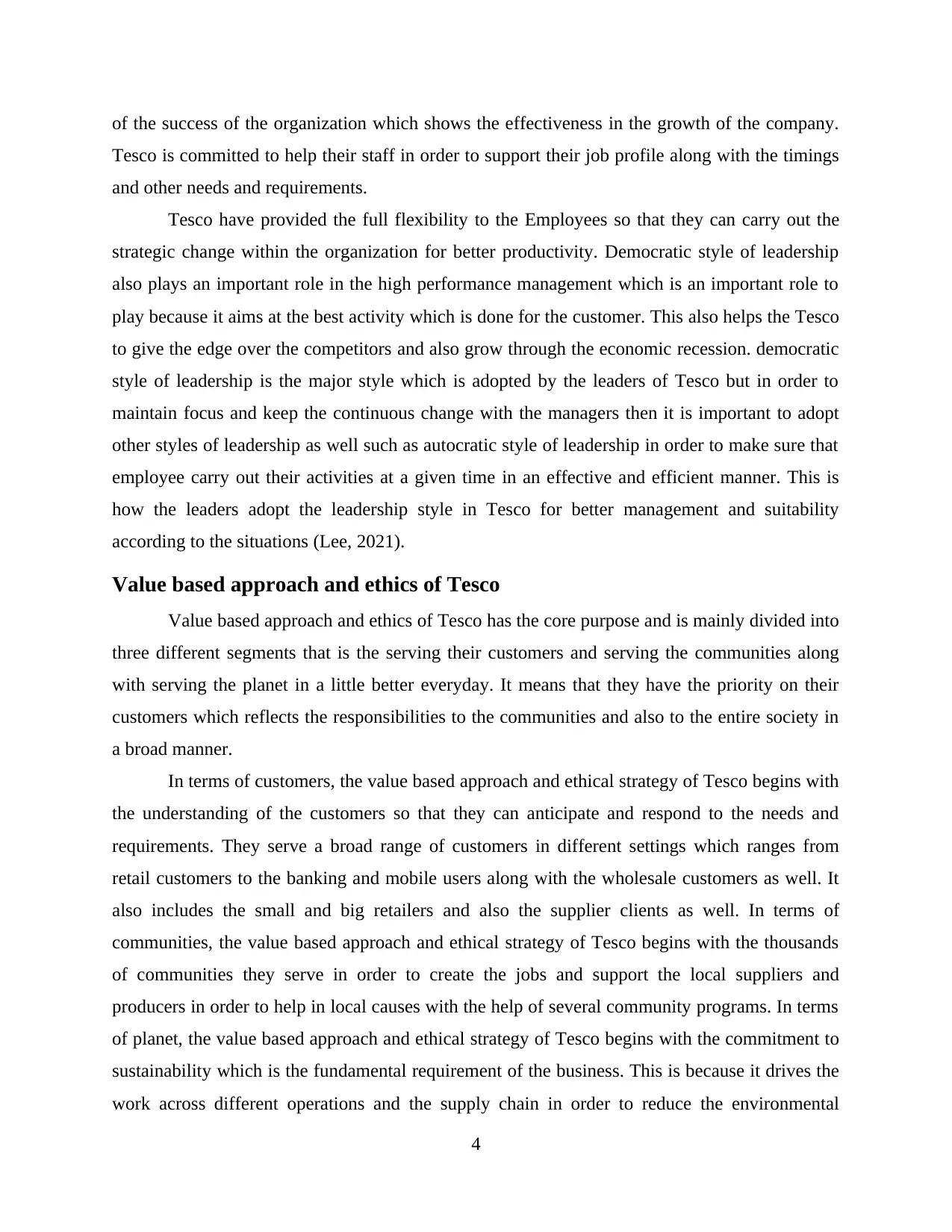
of the success of the organization which shows the effectiveness in the growth of the company.
Tesco is committed to help their staff in order to support their job profile along with the timings
and other needs and requirements.
Tesco have provided the full flexibility to the Employees so that they can carry out the
strategic change within the organization for better productivity. Democratic style of leadership
also plays an important role in the high performance management which is an important role to
play because it aims at the best activity which is done for the customer. This also helps the Tesco
to give the edge over the competitors and also grow through the economic recession. democratic
style of leadership is the major style which is adopted by the leaders of Tesco but in order to
maintain focus and keep the continuous change with the managers then it is important to adopt
other styles of leadership as well such as autocratic style of leadership in order to make sure that
employee carry out their activities at a given time in an effective and efficient manner. This is
how the leaders adopt the leadership style in Tesco for better management and suitability
according to the situations (Lee, 2021).
Value based approach and ethics of Tesco
Value based approach and ethics of Tesco has the core purpose and is mainly divided into
three different segments that is the serving their customers and serving the communities along
with serving the planet in a little better everyday. It means that they have the priority on their
customers which reflects the responsibilities to the communities and also to the entire society in
a broad manner.
In terms of customers, the value based approach and ethical strategy of Tesco begins with
the understanding of the customers so that they can anticipate and respond to the needs and
requirements. They serve a broad range of customers in different settings which ranges from
retail customers to the banking and mobile users along with the wholesale customers as well. It
also includes the small and big retailers and also the supplier clients as well. In terms of
communities, the value based approach and ethical strategy of Tesco begins with the thousands
of communities they serve in order to create the jobs and support the local suppliers and
producers in order to help in local causes with the help of several community programs. In terms
of planet, the value based approach and ethical strategy of Tesco begins with the commitment to
sustainability which is the fundamental requirement of the business. This is because it drives the
work across different operations and the supply chain in order to reduce the environmental
4
Tesco is committed to help their staff in order to support their job profile along with the timings
and other needs and requirements.
Tesco have provided the full flexibility to the Employees so that they can carry out the
strategic change within the organization for better productivity. Democratic style of leadership
also plays an important role in the high performance management which is an important role to
play because it aims at the best activity which is done for the customer. This also helps the Tesco
to give the edge over the competitors and also grow through the economic recession. democratic
style of leadership is the major style which is adopted by the leaders of Tesco but in order to
maintain focus and keep the continuous change with the managers then it is important to adopt
other styles of leadership as well such as autocratic style of leadership in order to make sure that
employee carry out their activities at a given time in an effective and efficient manner. This is
how the leaders adopt the leadership style in Tesco for better management and suitability
according to the situations (Lee, 2021).
Value based approach and ethics of Tesco
Value based approach and ethics of Tesco has the core purpose and is mainly divided into
three different segments that is the serving their customers and serving the communities along
with serving the planet in a little better everyday. It means that they have the priority on their
customers which reflects the responsibilities to the communities and also to the entire society in
a broad manner.
In terms of customers, the value based approach and ethical strategy of Tesco begins with
the understanding of the customers so that they can anticipate and respond to the needs and
requirements. They serve a broad range of customers in different settings which ranges from
retail customers to the banking and mobile users along with the wholesale customers as well. It
also includes the small and big retailers and also the supplier clients as well. In terms of
communities, the value based approach and ethical strategy of Tesco begins with the thousands
of communities they serve in order to create the jobs and support the local suppliers and
producers in order to help in local causes with the help of several community programs. In terms
of planet, the value based approach and ethical strategy of Tesco begins with the commitment to
sustainability which is the fundamental requirement of the business. This is because it drives the
work across different operations and the supply chain in order to reduce the environmental
4
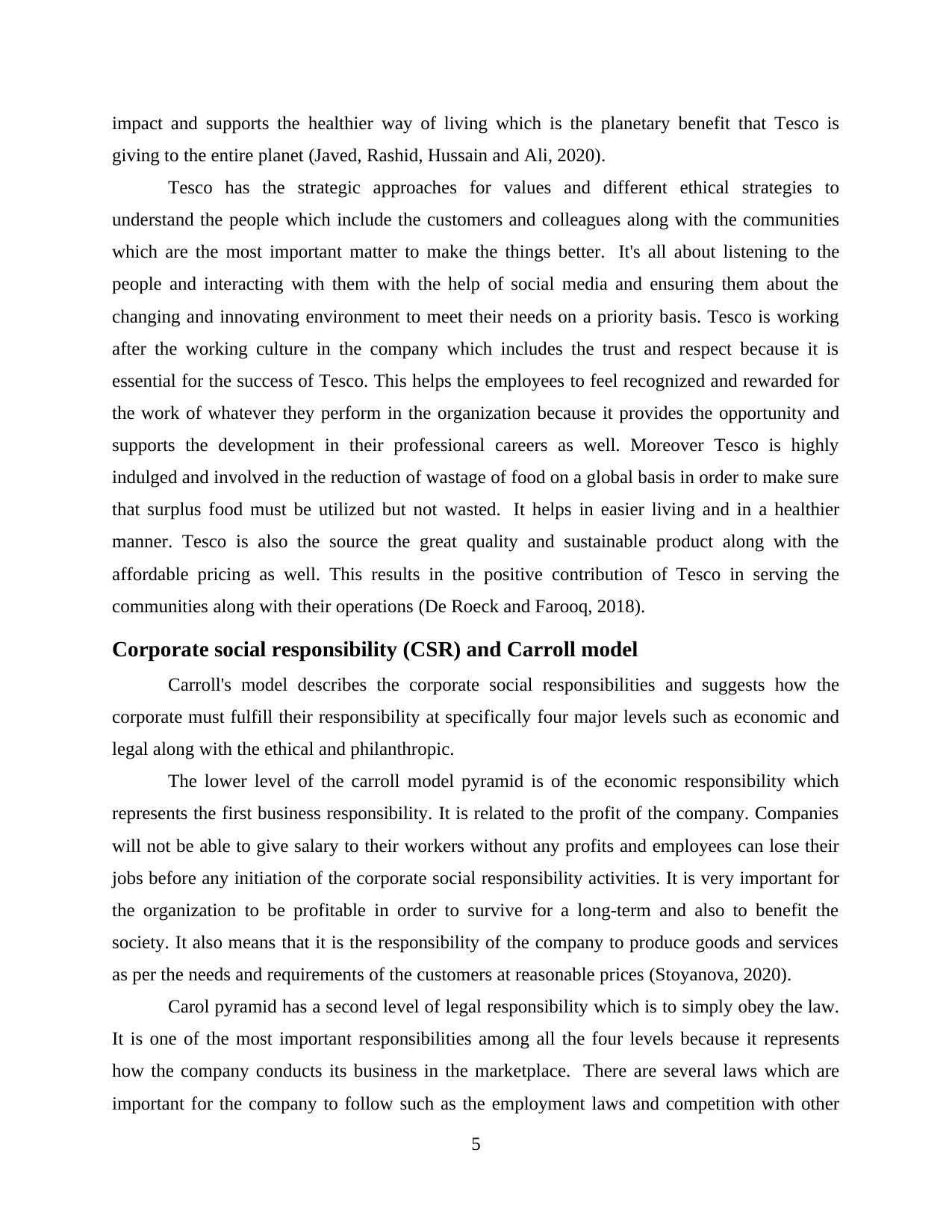
impact and supports the healthier way of living which is the planetary benefit that Tesco is
giving to the entire planet (Javed, Rashid, Hussain and Ali, 2020).
Tesco has the strategic approaches for values and different ethical strategies to
understand the people which include the customers and colleagues along with the communities
which are the most important matter to make the things better. It's all about listening to the
people and interacting with them with the help of social media and ensuring them about the
changing and innovating environment to meet their needs on a priority basis. Tesco is working
after the working culture in the company which includes the trust and respect because it is
essential for the success of Tesco. This helps the employees to feel recognized and rewarded for
the work of whatever they perform in the organization because it provides the opportunity and
supports the development in their professional careers as well. Moreover Tesco is highly
indulged and involved in the reduction of wastage of food on a global basis in order to make sure
that surplus food must be utilized but not wasted. It helps in easier living and in a healthier
manner. Tesco is also the source the great quality and sustainable product along with the
affordable pricing as well. This results in the positive contribution of Tesco in serving the
communities along with their operations (De Roeck and Farooq, 2018).
Corporate social responsibility (CSR) and Carroll model
Carroll's model describes the corporate social responsibilities and suggests how the
corporate must fulfill their responsibility at specifically four major levels such as economic and
legal along with the ethical and philanthropic.
The lower level of the carroll model pyramid is of the economic responsibility which
represents the first business responsibility. It is related to the profit of the company. Companies
will not be able to give salary to their workers without any profits and employees can lose their
jobs before any initiation of the corporate social responsibility activities. It is very important for
the organization to be profitable in order to survive for a long-term and also to benefit the
society. It also means that it is the responsibility of the company to produce goods and services
as per the needs and requirements of the customers at reasonable prices (Stoyanova, 2020).
Carol pyramid has a second level of legal responsibility which is to simply obey the law.
It is one of the most important responsibilities among all the four levels because it represents
how the company conducts its business in the marketplace. There are several laws which are
important for the company to follow such as the employment laws and competition with other
5
giving to the entire planet (Javed, Rashid, Hussain and Ali, 2020).
Tesco has the strategic approaches for values and different ethical strategies to
understand the people which include the customers and colleagues along with the communities
which are the most important matter to make the things better. It's all about listening to the
people and interacting with them with the help of social media and ensuring them about the
changing and innovating environment to meet their needs on a priority basis. Tesco is working
after the working culture in the company which includes the trust and respect because it is
essential for the success of Tesco. This helps the employees to feel recognized and rewarded for
the work of whatever they perform in the organization because it provides the opportunity and
supports the development in their professional careers as well. Moreover Tesco is highly
indulged and involved in the reduction of wastage of food on a global basis in order to make sure
that surplus food must be utilized but not wasted. It helps in easier living and in a healthier
manner. Tesco is also the source the great quality and sustainable product along with the
affordable pricing as well. This results in the positive contribution of Tesco in serving the
communities along with their operations (De Roeck and Farooq, 2018).
Corporate social responsibility (CSR) and Carroll model
Carroll's model describes the corporate social responsibilities and suggests how the
corporate must fulfill their responsibility at specifically four major levels such as economic and
legal along with the ethical and philanthropic.
The lower level of the carroll model pyramid is of the economic responsibility which
represents the first business responsibility. It is related to the profit of the company. Companies
will not be able to give salary to their workers without any profits and employees can lose their
jobs before any initiation of the corporate social responsibility activities. It is very important for
the organization to be profitable in order to survive for a long-term and also to benefit the
society. It also means that it is the responsibility of the company to produce goods and services
as per the needs and requirements of the customers at reasonable prices (Stoyanova, 2020).
Carol pyramid has a second level of legal responsibility which is to simply obey the law.
It is one of the most important responsibilities among all the four levels because it represents
how the company conducts its business in the marketplace. There are several laws which are
important for the company to follow such as the employment laws and competition with other
5
⊘ This is a preview!⊘
Do you want full access?
Subscribe today to unlock all pages.

Trusted by 1+ million students worldwide
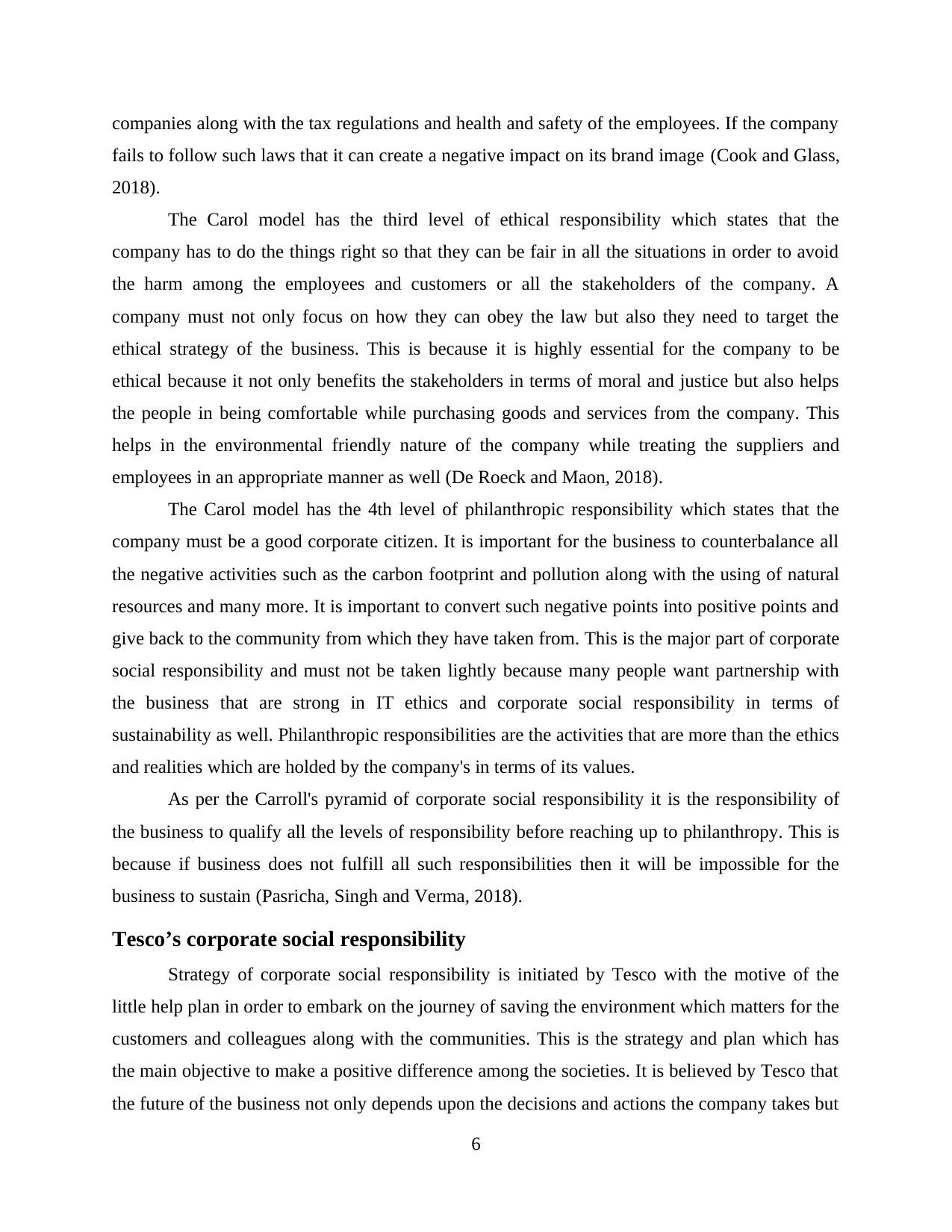
companies along with the tax regulations and health and safety of the employees. If the company
fails to follow such laws that it can create a negative impact on its brand image (Cook and Glass,
2018).
The Carol model has the third level of ethical responsibility which states that the
company has to do the things right so that they can be fair in all the situations in order to avoid
the harm among the employees and customers or all the stakeholders of the company. A
company must not only focus on how they can obey the law but also they need to target the
ethical strategy of the business. This is because it is highly essential for the company to be
ethical because it not only benefits the stakeholders in terms of moral and justice but also helps
the people in being comfortable while purchasing goods and services from the company. This
helps in the environmental friendly nature of the company while treating the suppliers and
employees in an appropriate manner as well (De Roeck and Maon, 2018).
The Carol model has the 4th level of philanthropic responsibility which states that the
company must be a good corporate citizen. It is important for the business to counterbalance all
the negative activities such as the carbon footprint and pollution along with the using of natural
resources and many more. It is important to convert such negative points into positive points and
give back to the community from which they have taken from. This is the major part of corporate
social responsibility and must not be taken lightly because many people want partnership with
the business that are strong in IT ethics and corporate social responsibility in terms of
sustainability as well. Philanthropic responsibilities are the activities that are more than the ethics
and realities which are holded by the company's in terms of its values.
As per the Carroll's pyramid of corporate social responsibility it is the responsibility of
the business to qualify all the levels of responsibility before reaching up to philanthropy. This is
because if business does not fulfill all such responsibilities then it will be impossible for the
business to sustain (Pasricha, Singh and Verma, 2018).
Tesco’s corporate social responsibility
Strategy of corporate social responsibility is initiated by Tesco with the motive of the
little help plan in order to embark on the journey of saving the environment which matters for the
customers and colleagues along with the communities. This is the strategy and plan which has
the main objective to make a positive difference among the societies. It is believed by Tesco that
the future of the business not only depends upon the decisions and actions the company takes but
6
fails to follow such laws that it can create a negative impact on its brand image (Cook and Glass,
2018).
The Carol model has the third level of ethical responsibility which states that the
company has to do the things right so that they can be fair in all the situations in order to avoid
the harm among the employees and customers or all the stakeholders of the company. A
company must not only focus on how they can obey the law but also they need to target the
ethical strategy of the business. This is because it is highly essential for the company to be
ethical because it not only benefits the stakeholders in terms of moral and justice but also helps
the people in being comfortable while purchasing goods and services from the company. This
helps in the environmental friendly nature of the company while treating the suppliers and
employees in an appropriate manner as well (De Roeck and Maon, 2018).
The Carol model has the 4th level of philanthropic responsibility which states that the
company must be a good corporate citizen. It is important for the business to counterbalance all
the negative activities such as the carbon footprint and pollution along with the using of natural
resources and many more. It is important to convert such negative points into positive points and
give back to the community from which they have taken from. This is the major part of corporate
social responsibility and must not be taken lightly because many people want partnership with
the business that are strong in IT ethics and corporate social responsibility in terms of
sustainability as well. Philanthropic responsibilities are the activities that are more than the ethics
and realities which are holded by the company's in terms of its values.
As per the Carroll's pyramid of corporate social responsibility it is the responsibility of
the business to qualify all the levels of responsibility before reaching up to philanthropy. This is
because if business does not fulfill all such responsibilities then it will be impossible for the
business to sustain (Pasricha, Singh and Verma, 2018).
Tesco’s corporate social responsibility
Strategy of corporate social responsibility is initiated by Tesco with the motive of the
little help plan in order to embark on the journey of saving the environment which matters for the
customers and colleagues along with the communities. This is the strategy and plan which has
the main objective to make a positive difference among the societies. It is believed by Tesco that
the future of the business not only depends upon the decisions and actions the company takes but
6
Paraphrase This Document
Need a fresh take? Get an instant paraphrase of this document with our AI Paraphraser
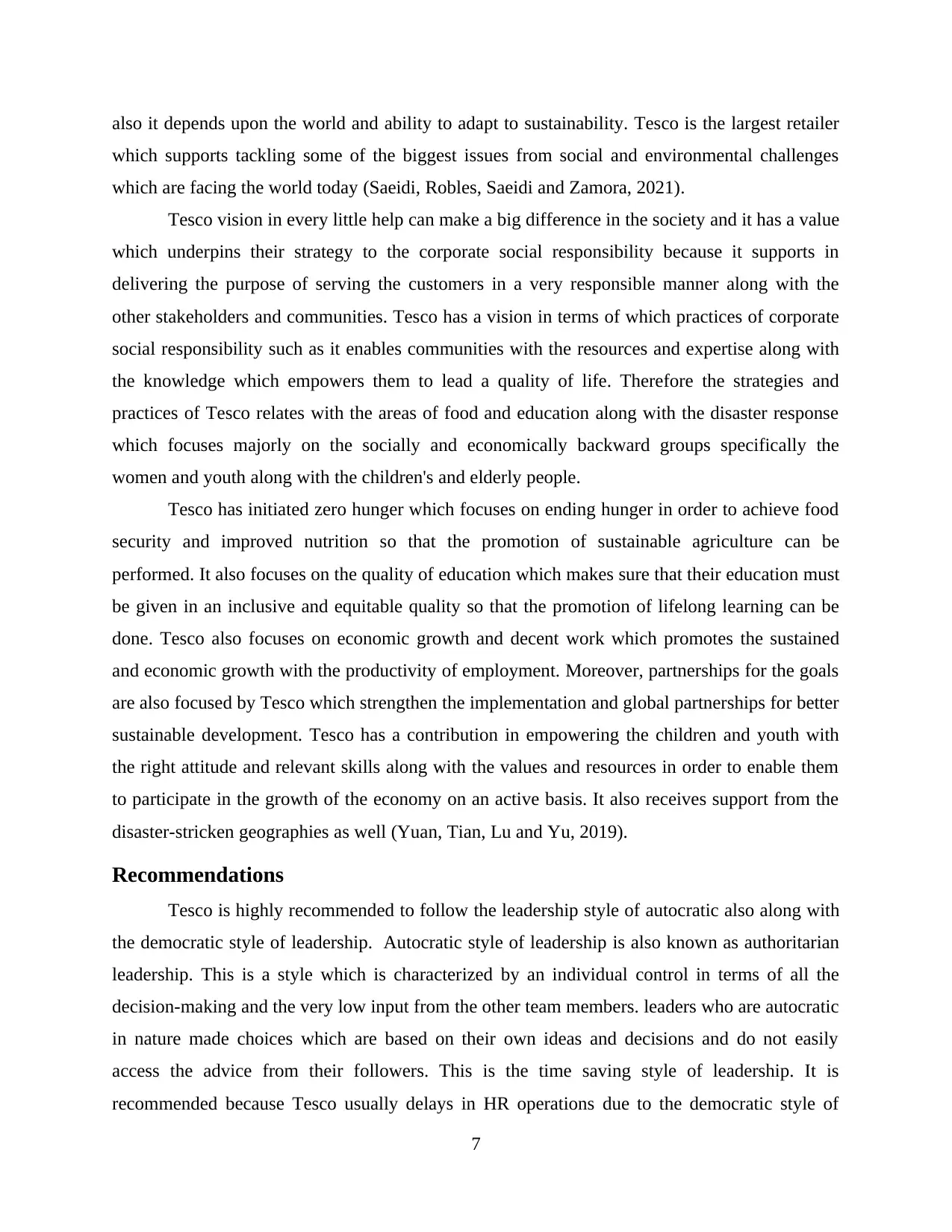
also it depends upon the world and ability to adapt to sustainability. Tesco is the largest retailer
which supports tackling some of the biggest issues from social and environmental challenges
which are facing the world today (Saeidi, Robles, Saeidi and Zamora, 2021).
Tesco vision in every little help can make a big difference in the society and it has a value
which underpins their strategy to the corporate social responsibility because it supports in
delivering the purpose of serving the customers in a very responsible manner along with the
other stakeholders and communities. Tesco has a vision in terms of which practices of corporate
social responsibility such as it enables communities with the resources and expertise along with
the knowledge which empowers them to lead a quality of life. Therefore the strategies and
practices of Tesco relates with the areas of food and education along with the disaster response
which focuses majorly on the socially and economically backward groups specifically the
women and youth along with the children's and elderly people.
Tesco has initiated zero hunger which focuses on ending hunger in order to achieve food
security and improved nutrition so that the promotion of sustainable agriculture can be
performed. It also focuses on the quality of education which makes sure that their education must
be given in an inclusive and equitable quality so that the promotion of lifelong learning can be
done. Tesco also focuses on economic growth and decent work which promotes the sustained
and economic growth with the productivity of employment. Moreover, partnerships for the goals
are also focused by Tesco which strengthen the implementation and global partnerships for better
sustainable development. Tesco has a contribution in empowering the children and youth with
the right attitude and relevant skills along with the values and resources in order to enable them
to participate in the growth of the economy on an active basis. It also receives support from the
disaster-stricken geographies as well (Yuan, Tian, Lu and Yu, 2019).
Recommendations
Tesco is highly recommended to follow the leadership style of autocratic also along with
the democratic style of leadership. Autocratic style of leadership is also known as authoritarian
leadership. This is a style which is characterized by an individual control in terms of all the
decision-making and the very low input from the other team members. leaders who are autocratic
in nature made choices which are based on their own ideas and decisions and do not easily
access the advice from their followers. This is the time saving style of leadership. It is
recommended because Tesco usually delays in HR operations due to the democratic style of
7
which supports tackling some of the biggest issues from social and environmental challenges
which are facing the world today (Saeidi, Robles, Saeidi and Zamora, 2021).
Tesco vision in every little help can make a big difference in the society and it has a value
which underpins their strategy to the corporate social responsibility because it supports in
delivering the purpose of serving the customers in a very responsible manner along with the
other stakeholders and communities. Tesco has a vision in terms of which practices of corporate
social responsibility such as it enables communities with the resources and expertise along with
the knowledge which empowers them to lead a quality of life. Therefore the strategies and
practices of Tesco relates with the areas of food and education along with the disaster response
which focuses majorly on the socially and economically backward groups specifically the
women and youth along with the children's and elderly people.
Tesco has initiated zero hunger which focuses on ending hunger in order to achieve food
security and improved nutrition so that the promotion of sustainable agriculture can be
performed. It also focuses on the quality of education which makes sure that their education must
be given in an inclusive and equitable quality so that the promotion of lifelong learning can be
done. Tesco also focuses on economic growth and decent work which promotes the sustained
and economic growth with the productivity of employment. Moreover, partnerships for the goals
are also focused by Tesco which strengthen the implementation and global partnerships for better
sustainable development. Tesco has a contribution in empowering the children and youth with
the right attitude and relevant skills along with the values and resources in order to enable them
to participate in the growth of the economy on an active basis. It also receives support from the
disaster-stricken geographies as well (Yuan, Tian, Lu and Yu, 2019).
Recommendations
Tesco is highly recommended to follow the leadership style of autocratic also along with
the democratic style of leadership. Autocratic style of leadership is also known as authoritarian
leadership. This is a style which is characterized by an individual control in terms of all the
decision-making and the very low input from the other team members. leaders who are autocratic
in nature made choices which are based on their own ideas and decisions and do not easily
access the advice from their followers. This is the time saving style of leadership. It is
recommended because Tesco usually delays in HR operations due to the democratic style of
7

leadership but for the situations when they have to make the urgent agents that it is suggested to
highly adopt the style of autocratic leadership for faster operations on urgent situations.
There are various practices and strategies which must be adopted by Tesco in terms of
corporate social responsibility such as the Tesco must adopt the business code of ethics and
follow the workplace health and safety programs. They must also commit to protecting the
environment and get the suppliers on board in order to be smart about donating the money. Tesco
March not green wash their business but explore the B corporation certification in terms of
corporate social responsibility. Other practices include the increment of transparency and
focusing on the equity along with the deepening of the community connections and reimagining
the risk tolerance which is also followed by the evolving of the idea of measurability and
increasing the creativity by improving the responsiveness (Aguinis and Glavas, 2019).
Tesco’s leadership and corporate social responsibility
Leadership and corporate social responsibilities are related to each other in Tesco.
Leaders are respectful and accountable along with being consistent in their strategies and open to
communication in Tesco. They have solid management skills and leadership traits which helps
the organization to maintain its environment of social responsibility and ethics by emphasizing
on the tactics and strategies which are related to the organization's wide code of fairness and
respect of others (Tsourvakas and Yfantidou, 2018).
Conclusion
It is concluded that leadership and corporate social responsibility is an important concept
to learn and study so that its applications can be applied in real world organizations. This is
because leaders are responsible for developing the policies of corporate social responsibility. It
helps in directing and guiding the team to maintain proper ethics in the organization. Therefore it
is important to analyze the leaders and leadership style according to the suitability of the
organization. It is essential to examine the value based approach and ethics related to the
company. It is necessary to determine the corporate social responsibility and Carrol model. it is
significant to gain the knowledge about corporate social responsibility of a particular industry. It
is vital to assess the recommendations on the entire linkage between leadership and corporate
social responsibility. it is imperative to evaluate the relationship between the leadership and the
corporate social responsibility for the particular organization. Hence this report covers all such
8
highly adopt the style of autocratic leadership for faster operations on urgent situations.
There are various practices and strategies which must be adopted by Tesco in terms of
corporate social responsibility such as the Tesco must adopt the business code of ethics and
follow the workplace health and safety programs. They must also commit to protecting the
environment and get the suppliers on board in order to be smart about donating the money. Tesco
March not green wash their business but explore the B corporation certification in terms of
corporate social responsibility. Other practices include the increment of transparency and
focusing on the equity along with the deepening of the community connections and reimagining
the risk tolerance which is also followed by the evolving of the idea of measurability and
increasing the creativity by improving the responsiveness (Aguinis and Glavas, 2019).
Tesco’s leadership and corporate social responsibility
Leadership and corporate social responsibilities are related to each other in Tesco.
Leaders are respectful and accountable along with being consistent in their strategies and open to
communication in Tesco. They have solid management skills and leadership traits which helps
the organization to maintain its environment of social responsibility and ethics by emphasizing
on the tactics and strategies which are related to the organization's wide code of fairness and
respect of others (Tsourvakas and Yfantidou, 2018).
Conclusion
It is concluded that leadership and corporate social responsibility is an important concept
to learn and study so that its applications can be applied in real world organizations. This is
because leaders are responsible for developing the policies of corporate social responsibility. It
helps in directing and guiding the team to maintain proper ethics in the organization. Therefore it
is important to analyze the leaders and leadership style according to the suitability of the
organization. It is essential to examine the value based approach and ethics related to the
company. It is necessary to determine the corporate social responsibility and Carrol model. it is
significant to gain the knowledge about corporate social responsibility of a particular industry. It
is vital to assess the recommendations on the entire linkage between leadership and corporate
social responsibility. it is imperative to evaluate the relationship between the leadership and the
corporate social responsibility for the particular organization. Hence this report covers all such
8
⊘ This is a preview!⊘
Do you want full access?
Subscribe today to unlock all pages.

Trusted by 1+ million students worldwide
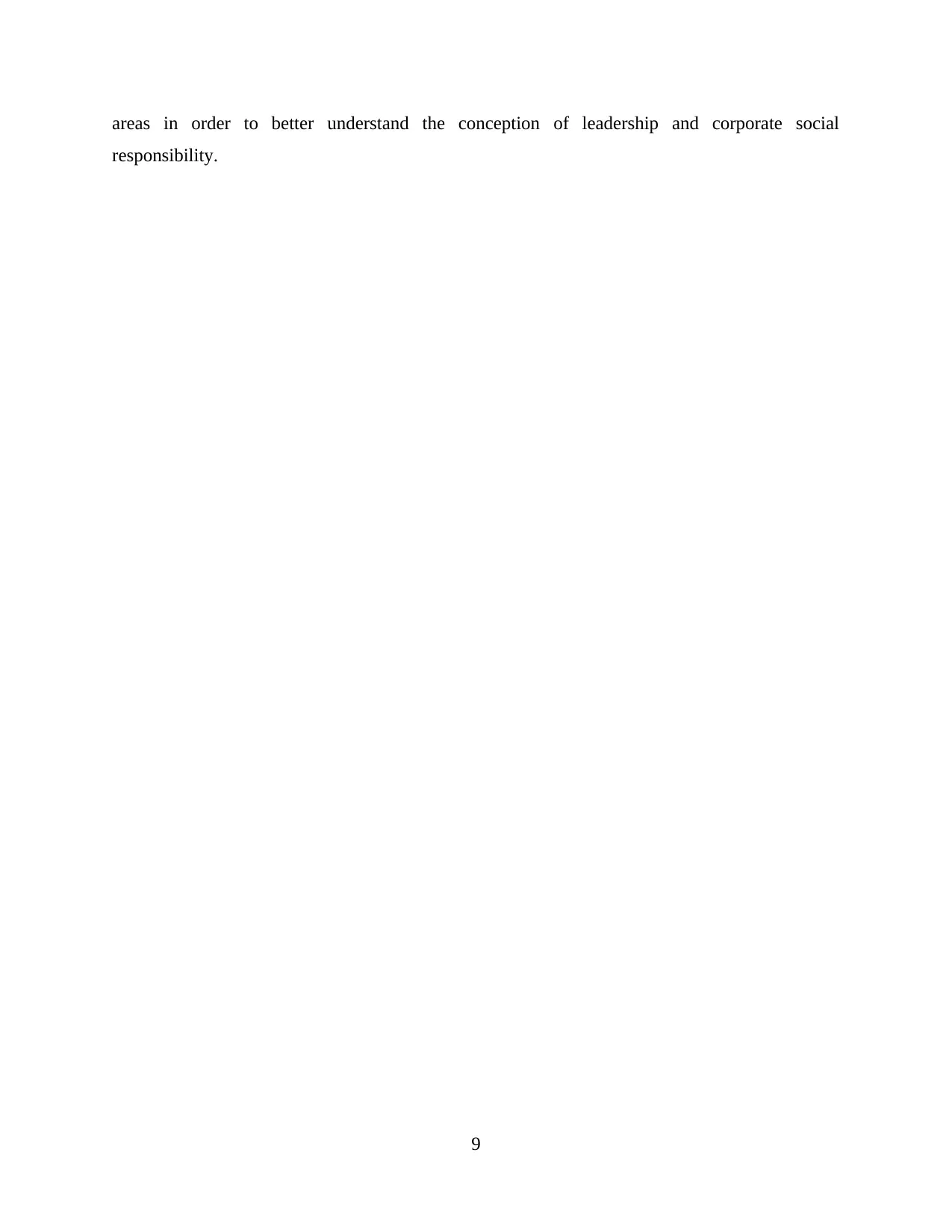
areas in order to better understand the conception of leadership and corporate social
responsibility.
9
responsibility.
9
Paraphrase This Document
Need a fresh take? Get an instant paraphrase of this document with our AI Paraphraser

References
Books and Journals
Aguinis, H. and Glavas, A., 2019. On corporate social responsibility, sensemaking, and the
search for meaningfulness through work. Journal of management, 45(3), pp.1057-1086.
Cook, A. and Glass, C., 2018. Women on corporate boards: Do they advance corporate social
responsibility?. Human relations, 71(7), pp.897-924.
De Roeck, K. and Farooq, O., 2018. Corporate social responsibility and ethical leadership:
Investigating their interactive effect on employees’ socially responsible behaviors. Journal
of Business Ethics, 151(4), pp.923-939.
De Roeck, K. and Maon, F., 2018. Building the theoretical puzzle of employees’ reactions to
corporate social responsibility: An integrative conceptual framework and research
agenda. Journal of Business Ethics, 149(3), pp.609-625.
Demir, A. and Budur, T., 2019. Roles of leadership styles in corporate social responsibility to
non-governmental organizations (NGOs). International Journal of Social Sciences &
Educational Studies, 5(4), pp.174-183.
Javed, M., Rashid, M.A., Hussain, G. and Ali, H.Y., 2020. The effects of corporate social
responsibility on corporate reputation and firm financial performance: Moderating role of
responsible leadership. Corporate Social Responsibility and Environmental
Management, 27(3), pp.1395-1409.
Kim, M.S. and Thapa, B., 2018. Relationship of ethical leadership, corporate social
responsibility and organizational performance. Sustainability, 10(2), p.447.
Lee, J.Y., 2021. Corporate Social Responsibility. In Encyclopedia of Sport Management (pp.
106-109). Edward Elgar Publishing.
Liu, W., Wei, W., Choi, T.M. and Yan, X., 2021. Impacts of leadership on corporate social
responsibility management in multi-tier supply chains. European Journal of Operational
Research.
Pasricha, P., Singh, B. and Verma, P., 2018. Ethical leadership, organic organizational cultures
and corporate social responsibility: An empirical study in social enterprises. Journal of
Business Ethics, 151(4), pp.941-958.
Saeidi, P., Robles, L.A.A., Saeidi, S.P. and Zamora, M.I.V., 2021. How does organizational
leadership contribute to the firm performance through social responsibility
strategies?. Heliyon, 7(7), p.e07672.
Saha, R., Cerchione, R., Singh, R. and Dahiya, R., 2020. Effect of ethical leadership and
corporate social responsibility on firm performance: A systematic review. Corporate
Social Responsibility and Environmental Management, 27(2), pp.409-429.
Stoyanova, S., 2020. Areas of Interaction Between Leadership and Corporate Social
Responsibility.
Tsourvakas, G. and Yfantidou, I., 2018. Corporate social responsibility influences employee
engagement. Social Responsibility Journal.
Yuan, Y., Tian, G., Lu, L.Y. and Yu, Y., 2019. CEO ability and corporate social
responsibility. Journal of Business Ethics, 157(2), pp.391-411.
10
Books and Journals
Aguinis, H. and Glavas, A., 2019. On corporate social responsibility, sensemaking, and the
search for meaningfulness through work. Journal of management, 45(3), pp.1057-1086.
Cook, A. and Glass, C., 2018. Women on corporate boards: Do they advance corporate social
responsibility?. Human relations, 71(7), pp.897-924.
De Roeck, K. and Farooq, O., 2018. Corporate social responsibility and ethical leadership:
Investigating their interactive effect on employees’ socially responsible behaviors. Journal
of Business Ethics, 151(4), pp.923-939.
De Roeck, K. and Maon, F., 2018. Building the theoretical puzzle of employees’ reactions to
corporate social responsibility: An integrative conceptual framework and research
agenda. Journal of Business Ethics, 149(3), pp.609-625.
Demir, A. and Budur, T., 2019. Roles of leadership styles in corporate social responsibility to
non-governmental organizations (NGOs). International Journal of Social Sciences &
Educational Studies, 5(4), pp.174-183.
Javed, M., Rashid, M.A., Hussain, G. and Ali, H.Y., 2020. The effects of corporate social
responsibility on corporate reputation and firm financial performance: Moderating role of
responsible leadership. Corporate Social Responsibility and Environmental
Management, 27(3), pp.1395-1409.
Kim, M.S. and Thapa, B., 2018. Relationship of ethical leadership, corporate social
responsibility and organizational performance. Sustainability, 10(2), p.447.
Lee, J.Y., 2021. Corporate Social Responsibility. In Encyclopedia of Sport Management (pp.
106-109). Edward Elgar Publishing.
Liu, W., Wei, W., Choi, T.M. and Yan, X., 2021. Impacts of leadership on corporate social
responsibility management in multi-tier supply chains. European Journal of Operational
Research.
Pasricha, P., Singh, B. and Verma, P., 2018. Ethical leadership, organic organizational cultures
and corporate social responsibility: An empirical study in social enterprises. Journal of
Business Ethics, 151(4), pp.941-958.
Saeidi, P., Robles, L.A.A., Saeidi, S.P. and Zamora, M.I.V., 2021. How does organizational
leadership contribute to the firm performance through social responsibility
strategies?. Heliyon, 7(7), p.e07672.
Saha, R., Cerchione, R., Singh, R. and Dahiya, R., 2020. Effect of ethical leadership and
corporate social responsibility on firm performance: A systematic review. Corporate
Social Responsibility and Environmental Management, 27(2), pp.409-429.
Stoyanova, S., 2020. Areas of Interaction Between Leadership and Corporate Social
Responsibility.
Tsourvakas, G. and Yfantidou, I., 2018. Corporate social responsibility influences employee
engagement. Social Responsibility Journal.
Yuan, Y., Tian, G., Lu, L.Y. and Yu, Y., 2019. CEO ability and corporate social
responsibility. Journal of Business Ethics, 157(2), pp.391-411.
10
1 out of 14
Related Documents
Your All-in-One AI-Powered Toolkit for Academic Success.
+13062052269
info@desklib.com
Available 24*7 on WhatsApp / Email
![[object Object]](/_next/static/media/star-bottom.7253800d.svg)
Unlock your academic potential
© 2024 | Zucol Services PVT LTD | All rights reserved.





